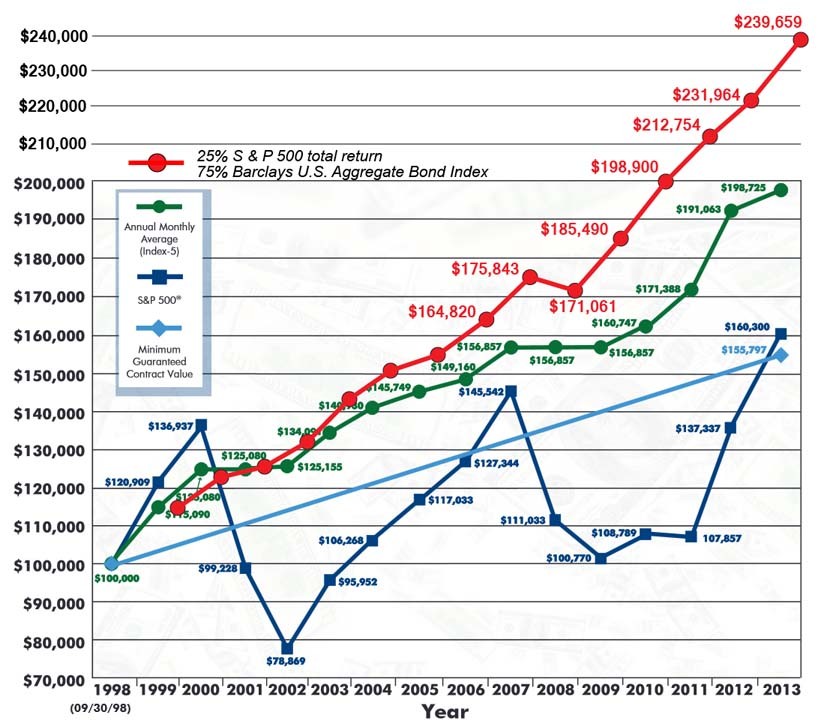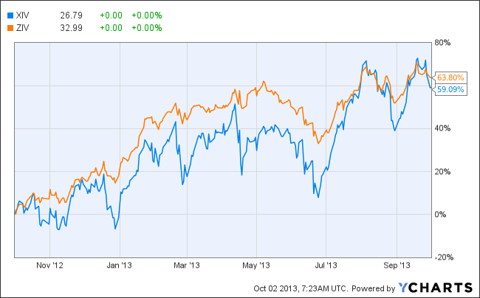A Look at All the VIX ETF Choices
Post on: 7 Апрель, 2015 No Comment

The impressive ETF boom that has unfolded over the last several years has been the result of a number of attractive features of the exchange-traded structure relative to traditional mutual funds. In addition to considerably lower expenses, intraday liquidity and enticing tax breaks have fueled interest in ETPs, which now number nearly 1,100 in the U.S. and hold close to $1 trillion in assets. As ETFs have become more targeted and specialized, they have allowed all types of investors to gain exposure to securities and strategies that were previously hard-to-reach. ETFs such as the Market Vectors China ETF (NYSEARCA:PEK ) offer exposure to unique assets like Chinas A-shares market, a new opportunity for U.S. investors (see Closer Look At The China A-Shares ETF ). ETFs have also been instrumental in making commodities a widely available asset class, making it possible for all types of investors to access both futures-based and physically backed funds focusing on everything from gold and silver to natural gas and crude oil.
Just as ETFs have democratized commodities, so too have they brought another previously hard-to-access asset class within reach. As evidenced by huge inflows and a surge in the number of product offerings, more and more investors are embracing volatility exposure as an effective tool. Perhaps the most popular volatility index is the VIX, or the Chicago Board Options Exchange Market Volatility Index, which measures the implied volatility of S&P 500 index options. The VIX was introduced in 1993 by Duke Universitys Professor Robert Whaley, and is a hypothetical measure of volatility based on metrics involving options trades and expectations of stock market volatility over the next 30 day period. As such, investors obviously cannot invest directly in a volatility index such as the VIX. But financial innovations of recent years have created opportunities for tapping into this asset class; futures on the VIX began trading back in 2004, and the first VIX-linked options debuted in 2006. More recently, ETNs linked to VIX-related indexes popped up, and have multiplied in recent weeks and months.
The appeal of exposure to volatility through VIX futures contracts is generally related to the strong inverse correlation with stock markets. Also known as the fear index, the VIX tends to climb when anxiety over the short-term outlook for equity market spikes and fall when markets push higher. As such, exposure to the VIX can be an effective hedging tool for various strategies or a way to bet on turmoil in U.S. equity markets. A great example comes from the May 6th flash crash where the popular VIX ETN surged over 35% intraday as markets went into a furious downward spiral. Most investors use these funds for short term exposure, as they are subject to hefty price swings, but as the ETF space expands, so too do the strategies that follow the fear index.
As interest in these funds has grown, recent weeks have seen a wave of activity in the ETF space, with numerous options now available for various kinds of VIX exposure. Below we outline the options that are currently available to investors, and their differing strategies that all track volatility:
Short-Term VIX ETNs
It is important to note that none of the options, futures, or ETNs linked to the VIX offer exposure to changes in the spot price of the index. But short-term VIX ETNS, which generally establish long positions in the first and second month VIX contracts on a rolling basis, will often move in line with the spot VIXat least in the short term. Because the market for VIX futures contracts is often contangoed and sloping steeply upward in the short term, the roll yield incurred by a short term strategy can be significant. Currently, there are two short-term VIX ETNs:
- iPath S&P 500 VIX Short-Term Futures ETN (NYSEARCA:VXX ): The first VIX ETN to hit the market, VXX has become a popular option for short-term investors seeking out volatility exposure. Though VXX has seen some big jumps this year and can be an efficient component of more sophisticated strategies, it has faced some stiff headwinds in the form of contango as well. VXX has lost over 65% on the year, while the change in the spot VIX in 2010 has been minimal.
- VIX Short-Term ETN (NASDAQ:VIIX ): This VelocityShares fund is set up very similarly to that of VXX. VIIX, however tracks a slightly different index, as it is linked to the S&P 500 VIX Short-Term Futures Index Excess Return (the iPath product is linked to the total return version of the same index). The ETN is a recent addition, having debuted in late November.
Mid-Term VIX ETNs
These ETNs offer investors the opportunity to invest in contracts that are several months out, as opposed to the first and second month futures that are offered by short-term VIX funds. As a result, mid-term VIX ETNs are generally less sensitive to changes in the spot VIX, but also less vulnerable to the impact of contango in futures markets.
- iPath S&P 500 VIX Mid-Term Futures ETN (NYSEARCA:VXZ ) : VXZ offers returns based on rolling long positions in the fourth, fifth, sixth, and seventh month VIX contracts. While VXZ may seem very similar to its short-term counterpart, the risk/return profile is actually very different. This ETN will exhibit less volatility than VXX (which in turn generally exhibits less volatility than the spot VIX), and the focus on longer-dated contracts mitigates the impact of contango somewhat.
- VIX Medium-Term ETN (NASDAQ:VIIZ ) : VIIZ is another VelocityShares fund that launched at the end of November. The fund will track the mid-term version of the same index as VIIX, giving investors another option besides the iPath ETN for exposure to mid-term volatility exposure.
Leveraged VIX ETNs
Just as there are ETFs offering leveraged exposure to many popular stock and bond indexes, it is now possible for investors to establish amplified daily exposure to VIX-related indexes. By adding leverage to an asset class that often shows big price swings, the result is an extremely volatile security. Currently, there are three leveraged VIX ETNs available:

- Daily 2x VIX Short-Term ETN (NASDAQ:TVIX ): This ETF is a leveraged version of VIIX, as it offers daily 2x leverage to an index comprised of short-term VIX futures contracts.
- Daily 2x VIX Medium-Term ETN (NASDAQ:TVIZ ) : TVIZ is the 2x version of VIIZ, the recently-launched mid-term volatility index from VelocityShares. While it wont generally deliver price swings as big as TVIX, this fund is still likely to show big price movements, and is designed primarily for sophisticated traders with a short time horizon.
- iPath Long Enhanced S&P 500 VIX Mid-Term Futures ETN (VZZ) : This iPath product offers another option for leveraged VIX exposure, seeking to deliver a leveraged return on the index consisting of a daily rolling long position in the fourth, fifth, sixth, and seventh month VIX futures contracts.
Inverse VIX ETNs
Inverse VIX ETPs are a relatively new introduction, and can be useful for investors looking to bet on a decline in expected equity market volatility. These funds are probably not for buy-and-hold investors, but may offer advantages to traders who utilize more complex strategies to generate returns.
- Barclays ETN+ Inverse S&P 500 VIX Short-Term Futures ETN (NYSEARCA:XXV ): This inverse VIX fund measures short term contracts, and trades under reverse ticker of the original Barclays iPath volatility fund, VXX. The fund offers inverse exposure to the S&P 500 VIX Short-Term Futures Index Excess Return, which is designed to reflect the returns that are potentially available through an unleveraged investment in short-term futures contracts on the CBOE Volatility Index.
- Daily Inverse VIX Short-Term ETN (NASDAQ:XIV ) : This fund will measure a similar index as XXV and is also a short-term inverse VIX fund.
- Daily Inverse VIX Medium-Term ETN (NASDAQ:ZIV ): VelocityShares also offers an option for inverse exposure to a mid-term VIX index; ZIV should appreciate when stocks jump and slide and will struggle when the VIX is on the rise.
Long/Short VIX ETN
Access to the VIX is no longer just limited to the traditional sub-setslong, inverse, leveraged, etc. UBS recently debuted its E-TRACS Daily Long-Short VIX ETN (NYSEARCA:XVIX ), a product that offers exposure to a strategy designed to exploit the nuances of futures-based access to volatility markets. XVIXs strategy involves establishing a 100% long position in the S&P 500 VIX Mid-Term Futures Index Excess Return with a short 50% position in the S&P 500 VIX Short-Term Futures Index Excess Return, with daily rebalancing of the long and short positions.
The investment thesis behind XVIX focuses on the systematically high risk premium for near-term VIX futures relative to mid-term contracts. By maintaining long exposure to mid-term contractsthose that are between four and seven months from expirationand short exposure to those contracts nearing expiration, XVIX presents an opportunity to capture some of that risk premium regardless of whether equity market volatility is increasing or decreasing. The fund charges an expense ratio of 0.85%.
VEQTOR ETN
One of the recent additions to the ETF lineup came from Barclays, which rolled out an ETN linked to a strategy depending on the level of volatility observed in the market. The Barclays ETN+ S&P VEQTOR ETN (NYSEARCA:VQT ) is linked to the S&P 500 Dynamic VEQTOR, an index that provides exposure to large cap U.S. equities with an implied volatility hedge by allocating assets to three asset classes: stocks, volatility, and cash. Depending on the magnitude and trend of volatility, the equity allocation maintained by the ETN will shift between 60% (if volatility spikes to more than 45% and an uptrend is detected) and 97.5% (if realized volatility drops to less than 10% and no trend is detected).
Non-VIX Volatility ETN
While the VIX is the popular measure of volatility, there are other volatility indexes available that use their own metrics to track market uncertainty:
- C-Tracks ETN Citi Volatility Index Total Return (NYSEARCA:CVOL ): This ETF tracks the Citi Volatility Index Total Return, which is designed to measure directional exposure to the implied volatility of large cap U.S. stocks. The fund bases its investments off of the volatility calculated by Citigroup (NYSE:C ) with a return due date of November 12, 2020.
Word Of Caution
As the ETF world continues to expand, so too does the complexity of the new products hitting the market. There are now nearly 1,100 exchange traded products available to U.S. investors, and while many of the first generations of products are plain vanilla funds designed with buy-and-holders in mind, recent innovations have increasingly targeted sophisticated investors. The majority of VIX funds, for example, arent designed to be held over the long term and can exhibit significant volatility. So far in 2010, the average daily change (in absolute terms) of VXX was 3%, with the maximum movement coming in at a 14% change in just one day (the fund has also moved by over 10% on eight separate days this year).
Besides the volatility, contango in futures markets introduces additional drivers of performance and layers of complexity to the risk/return profiles. The VIX ETNs now available to investors can be very powerful tools, facilitating sophisticated trading strategies or serving as effective hedges. But they are complex products, and as such should be used with caution (see also Using ETFs As Portfolio Insurance ).
Disclosure: No positions at time of writing
Disclaimer: ETF Database is not an investment advisor, and any content published by ETF Database does not constitute individual investment advice. The opinions offered herein are not personalized recommendations to buy, sell or hold securities. From time to time, issuers of exchange-traded products mentioned herein may place paid advertisements with ETF Database. All content on ETF Database is produced independently of any advertising relationships.














